 Many frogs and toads that are collected or purchased and kept as pets will greedily accept crickets and mealworms, the food items most easily obtained from pet stores. Most thrive on this fare for a time, but eventually develop nutritional disorders and expire long before they have reached their potential life-span. Following are some useful tips for those keeping American Bullfrogs, White’s Treefrogs, Budgett’s Frogs, most Toads and similar species. Please see my other Amphibian Care Articles for information on feeding Poison Frogs, Mantellas, African Clawed Frogs, Horned Frogs and others requiring specialized diets, or write in with your questions. Read More »
Many frogs and toads that are collected or purchased and kept as pets will greedily accept crickets and mealworms, the food items most easily obtained from pet stores. Most thrive on this fare for a time, but eventually develop nutritional disorders and expire long before they have reached their potential life-span. Following are some useful tips for those keeping American Bullfrogs, White’s Treefrogs, Budgett’s Frogs, most Toads and similar species. Please see my other Amphibian Care Articles for information on feeding Poison Frogs, Mantellas, African Clawed Frogs, Horned Frogs and others requiring specialized diets, or write in with your questions. Read More »
Snake and Lizard Losses may Provide Evidence for a Global Reptile Decline
 Studies in several countries recently hinted that snakes may be declining worldwide, in much the same manner as has been shown for scores of amphibian species (please see article below). This month (October, 2010), scientists at the University of Arizona have documented massive declines in both snakes and lizards in a well-protected reserve, adding to fears that major extinctions lie ahead.
Studies in several countries recently hinted that snakes may be declining worldwide, in much the same manner as has been shown for scores of amphibian species (please see article below). This month (October, 2010), scientists at the University of Arizona have documented massive declines in both snakes and lizards in a well-protected reserve, adding to fears that major extinctions lie ahead.
Frightening Similarity to Earlier Studies
Populations of 8 snake and 6 lizard species in Arizona’s Organ Pipe National Park were found to have declined by 50% between 1998 and 2002, and have not recovered. The reptiles in question had been monitored carefully for 22 years, so accurate baseline numbers were available. The species that showed significant declines included Regal Horned, Zebra-Tailed and Red-Back Whiptail Lizards, Mojave and Western Diamondback Rattlesnakes, Gopher Snakes and King Snakes. Read More »
The Eastern Newt – the Many Subspecies and Hybrids of a Poplar Pet – Part 1
 The Eastern Newt (Notophthalmus viridescens) is, in most parts of the USA, the salamander most likely to be encountered in either the wild or in pet stores. It is a wonderful species for beginning hobbyists, yet has such a complicated life style that even long-experienced herpetologists remain interested in keeping them.
The Eastern Newt (Notophthalmus viridescens) is, in most parts of the USA, the salamander most likely to be encountered in either the wild or in pet stores. It is a wonderful species for beginning hobbyists, yet has such a complicated life style that even long-experienced herpetologists remain interested in keeping them.
Many unusual hybrids, varying color phases and related species have found their way into captivity. Today I’ll touch on their care and feeding; I’ll discuss some of the many types available in Part 2. Read More »
The Natural History and Captive Care of Softshell Turtles – Part 2
The world’s 24 species of Softshell Turtles (Family Trionychidae) depart radically from the typical turtle body plan, and their behavior holds many surprises for those familiar with “normal” turtles. In Part 1 of this article we looked at their natural history and diet, and discussed the basics of captive care. I also relayed some of the difficulties inherent in working with these delicate creatures – difficulties that resulted in the loss of some huge and rare individuals of several species. I hope you enjoy the following Softshell observations and stories. Read More »
Conservation Update – The Bizarre, Skin-Breathing Lake Titicaca Frog
The huge, aquatic, baggy-skinned Lake Titicaca Frog (Telmatobius culeus) has fascinated me since childhood, when I first came upon a group at the Bronx Zoo. I returned again and again to stare as the unusual beasts – largest of the world’s aquatic frogs – did “push-ups” at the bottom of their cold aquarium (they breathe largely through their loose skin, and rock back and forth in order to increase the area exposed to the water). Because the frogs lived for so long – nearly 30 years in one case – I was able to work with same individuals I had earlier observed once I began my zoo-keeping career. Read More »
 That Reptile Blog – Reptile, Amphibian and Exotic Pet Care and Information
That Reptile Blog – Reptile, Amphibian and Exotic Pet Care and Information
